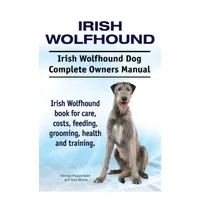Great Dane vs Irish Wolfhound: Which giant breed is right for you?
These giant breeds may be similar in height, but there are a few things that separate the Great Dane and the Irish Wolfhound
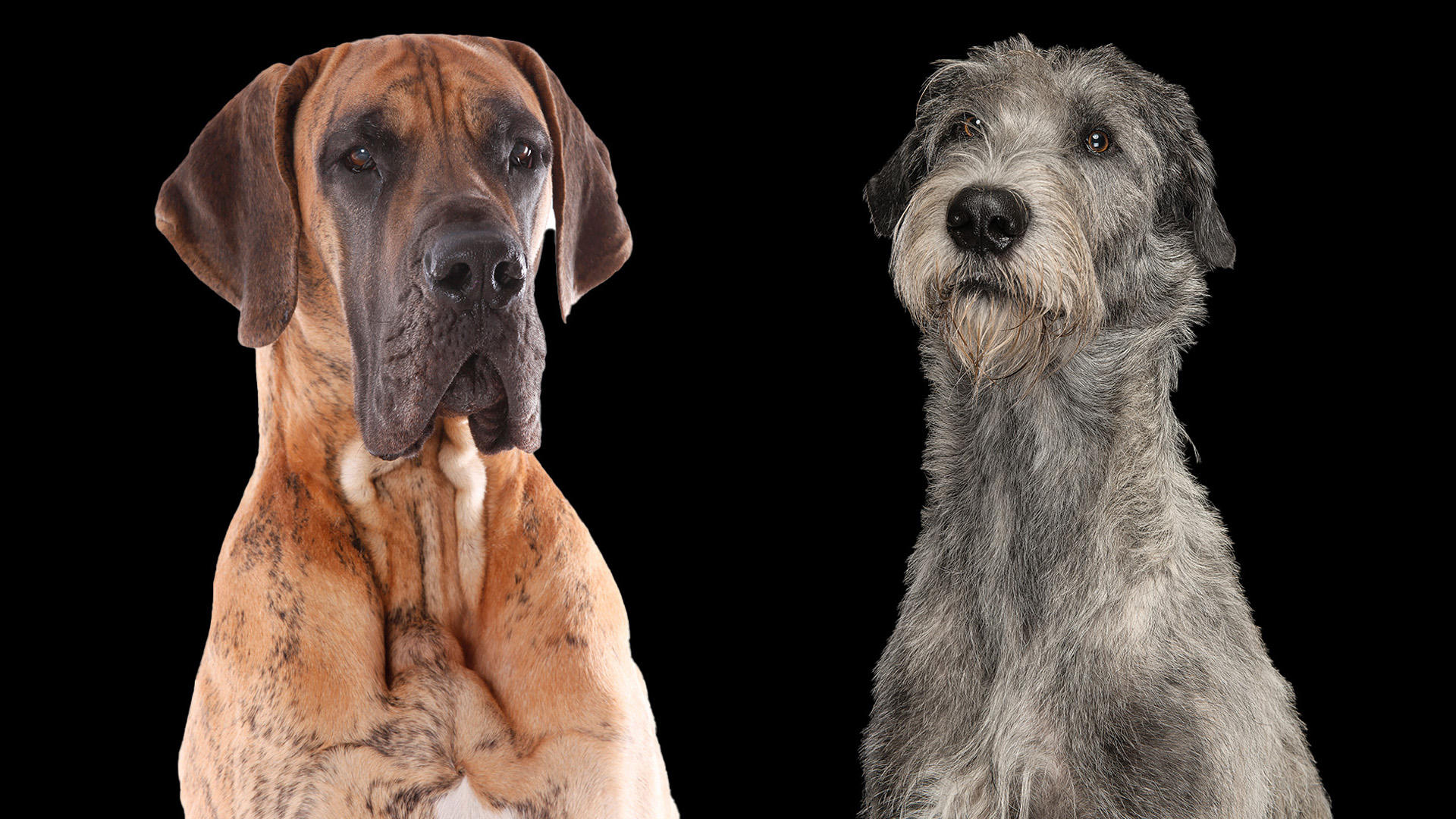
If you've ever wondered about the difference between the Great Dane vs Irish Wolfhound, you're in the right place! While these two gentle giants both make wonderful companions, there are a few key differences that you'll want to be aware of.
Two of the largest dog breeds, both the Great Dane and the Irish Wolfhound are soft-hearted and tend to make great friends for older children. They tend to bond well with other dogs and are very loyal and kind-hearted.
Great Danes tend to be goofy and affectionate, whereas Irish Wolfhounds are typically sensitive and serene in nature. Great Danes love to have fun and like lots of attention, but Irish Wolfhounds prefer quiet and calm. Great Danes are also highly flexible and are quite happy with just about any living environment, while Irish Wolfhounds need plenty of space to run around and stretch their legs.
To help you figure out which breed is right for you, we turned to expert vet Dr Hannah Godfrey. Below, she compares the training, grooming and exercise needs of both breeds and reveals which health conditions these two dogs are prone to. Let's take a look...
Size: Great Dane vs Irish Wolfhound
When it comes to large breed dogs, you won't find many pups bigger than these two huge hounds! There's virtually nothing in it on the height front, with the Great Dane and the Irish Wolfhound both measuring around 30-32 inches tall.
Where these breeds do differ substantially is weight, with the Great Dane being the heavier of the two. It's not unusual for males to tip the scales at 175 pounds, whereas male Irish Wolfhounds are considerably leaner at 120 pounds.
Appearance: Great Dane vs Irish Wolfhound
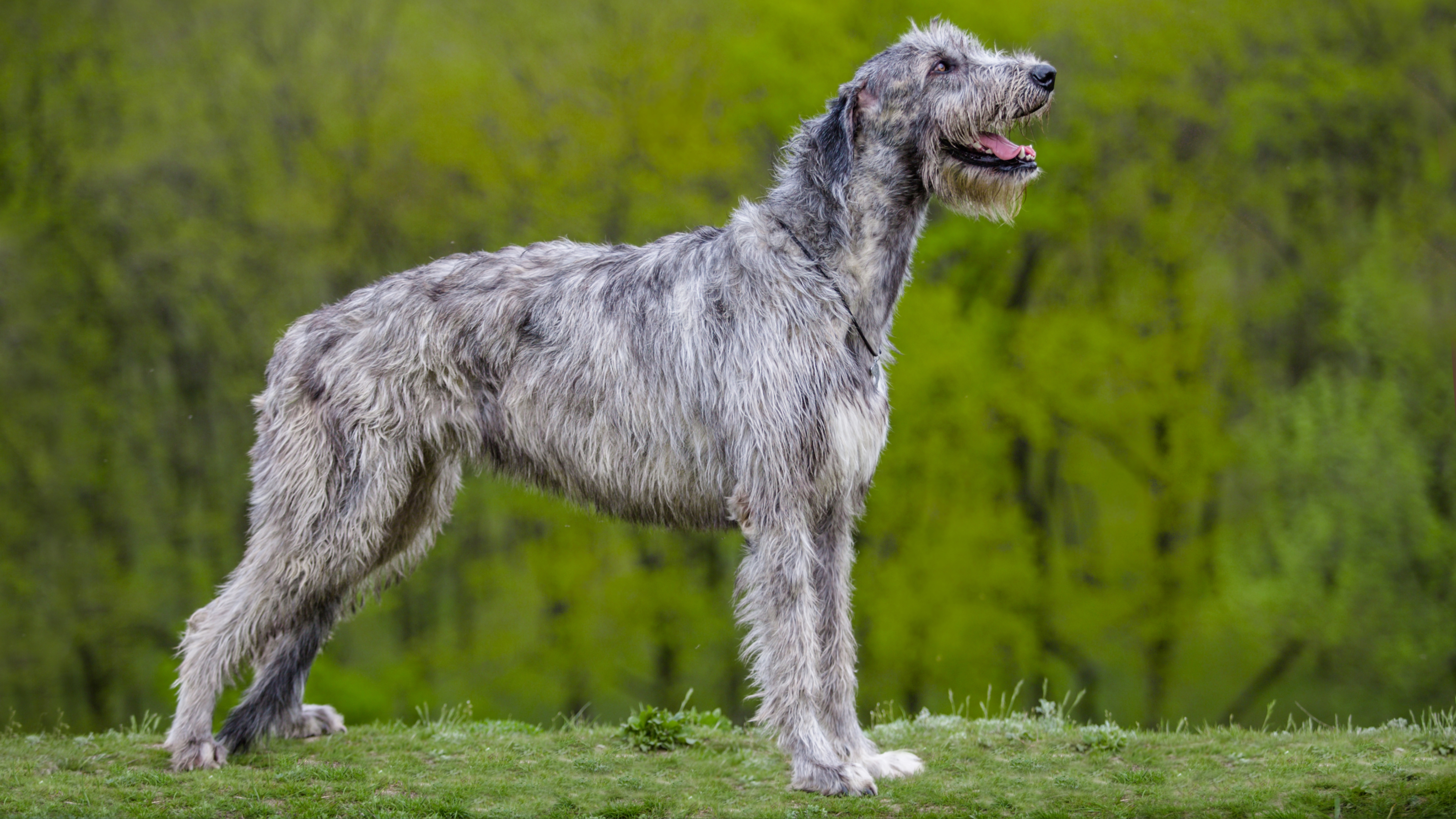
They may be similar in height, but these two breeds definitely differ in appearance, so you'll have no trouble telling them apart.
Get the best advice, tips and top tech for your beloved Pets
Great Danes have a mastiff body type, which means they have a very heavy and robust frame. They have square muzzles, large ears and their short and smooth coat comes in seven different colors, including blue, brindle, fawn and harlequin.
In contrast, Irish Wolfhounds are sighthounds, so are lean with an agile build, and they have long, angular muzzles and small ears. Their outer coat is long, shaggy and wiry and comes in six official coat types, including grey, pure white and red.
Trainability: Great Dane vs Irish Wolfhound
Planning on training your dog on your own? If so, knowing how quickly a breed can master new commands may be factor highly into your decision making process when it comes to adopting a dog.
According to Dr Godfrey, training is essential for both the Great Dane and the Irish Wolfhound due to their size and strength.
"Irish Wolfhounds are particularly intelligent, which can make training a little easier, but neither dog is known for being particularly eager to please, which can make training a challenge," she explains.
"As puppies and adolescents, both dogs can be a little clumsy and destructive, so starting training at an early age is important. Use positive reinforcement with high-value dog treats or toys as a reward for good behavior, and be firm and consistent."
Dr Godfrey says that training these breeds isn’t quite as easy as some others, so you will need to be patient, but it’s worth it to have a safe and obedient companion.
Exercise: Great Dane vs Irish Wolfhound
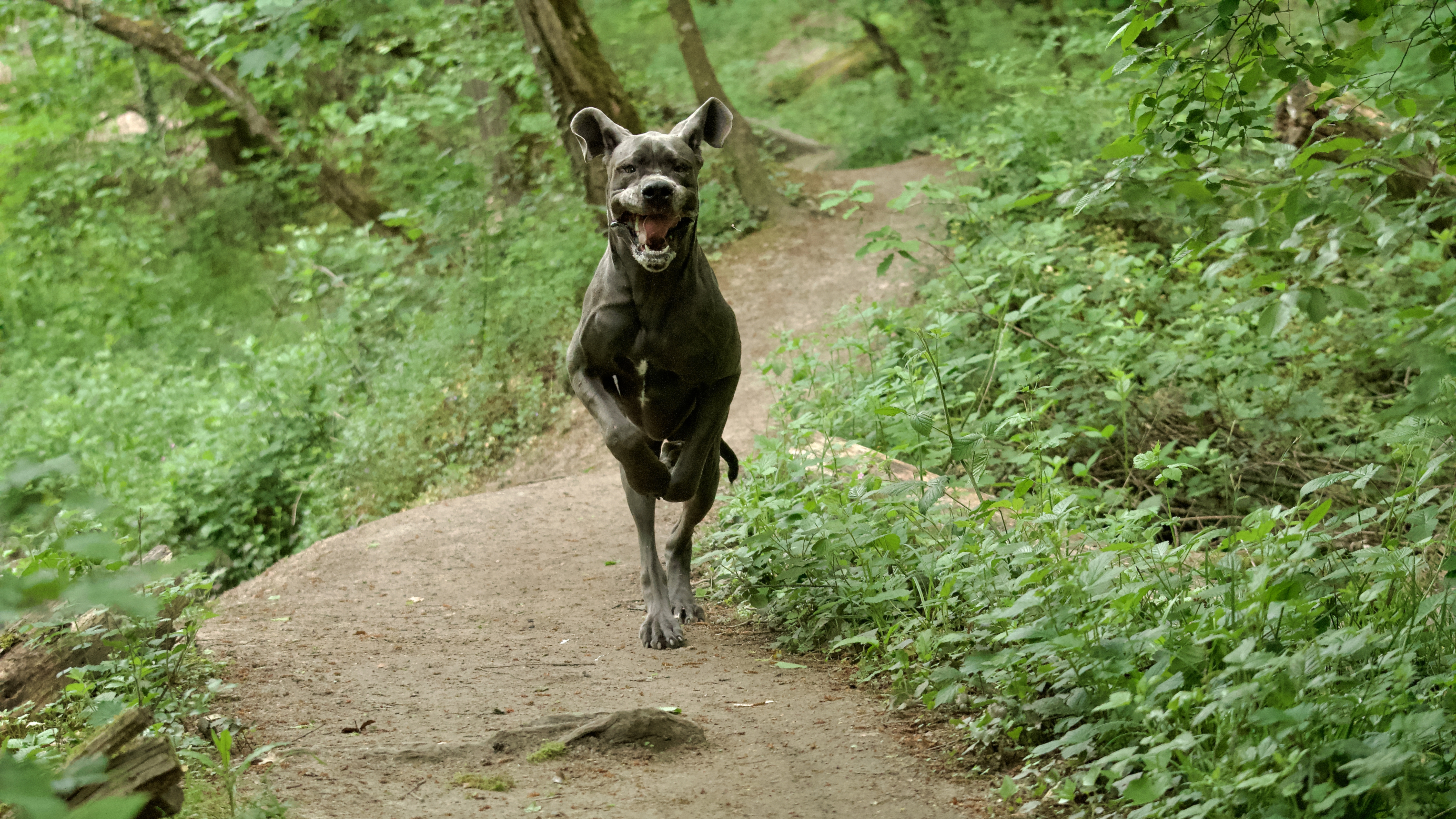
Large dogs require a large amount of exercise, right? Well, not necessarily as Dr Godfrey explains.
"To look at them, you might assume that both Great Danes and Irish Wolfhounds crave lots of exercise, because they’re so big. But actually, both dogs can be very laid back and even a bit lazy if they’re allowed to be," she says.
Still, that doesn't mean you want to let them be couch potatoes. After all, being lazy some of the time is fine but inactivity on a regular basis can lead to health problems.
"It’s really important to give them regular exercise to keep them fit and healthy," confirms Dr Godfrey, adding that both breeds require "at least an hour or two daily, but longer or more often when you can."
She goes on to explain that both breeds benefit from off-leash exercise, and letting them run free serves a double purpose as it can help give you a break from holding them.
"But it’s really important to only let them off when they’re somewhere secure, particularly Irish Wolfhounds, who have a tendency to chase," she explains.
There are so many different ways to workout with your pet, so don't be afraid to mix things up a bit to keep life interesting for both you and your canine companion.
Grooming: Great Dane vs Irish Wolfhound
While some breeds require little more than a quick brush once a week to keep their fur in tip-top condition, other breeds have coats that require daily care. Considering the grooming needs of different breeds and how much time you have to devote to pampering your pup can help you to find the right dog for you.
"If you’re looking for a low-maintenance breed, the Irish Wolfhound may not be the best choice," says Dr. Godfrey. "These dogs have a double coat with a long, coarse outer coat that needs regular brushing to prevent mats. Thankfully, unlike some other breeds, Irish Wolfhounds don’t shed excessively, so brushing once or twice a week should be sufficient.
"In comparison, Great Danes are relatively easy for most of the year, because their smooth coat only requires weekly brushing. However, during shedding season they lose lots of hair and require brushing everyday."
Regardless of which breed you choose, investing in one of the best dog brushes can help make those grooming sessions that little bit easier. Bristle and slicker brushes are a great choice for Irish Wolfhounds as they remove loose hair while helping to maintain their wiry coats.
Bristle brushes and rubber mitts are often a winner for Great Danes, helping to keep their short, thick coat nice and smooth.
Health: Great Dane vs Irish Wolfhound
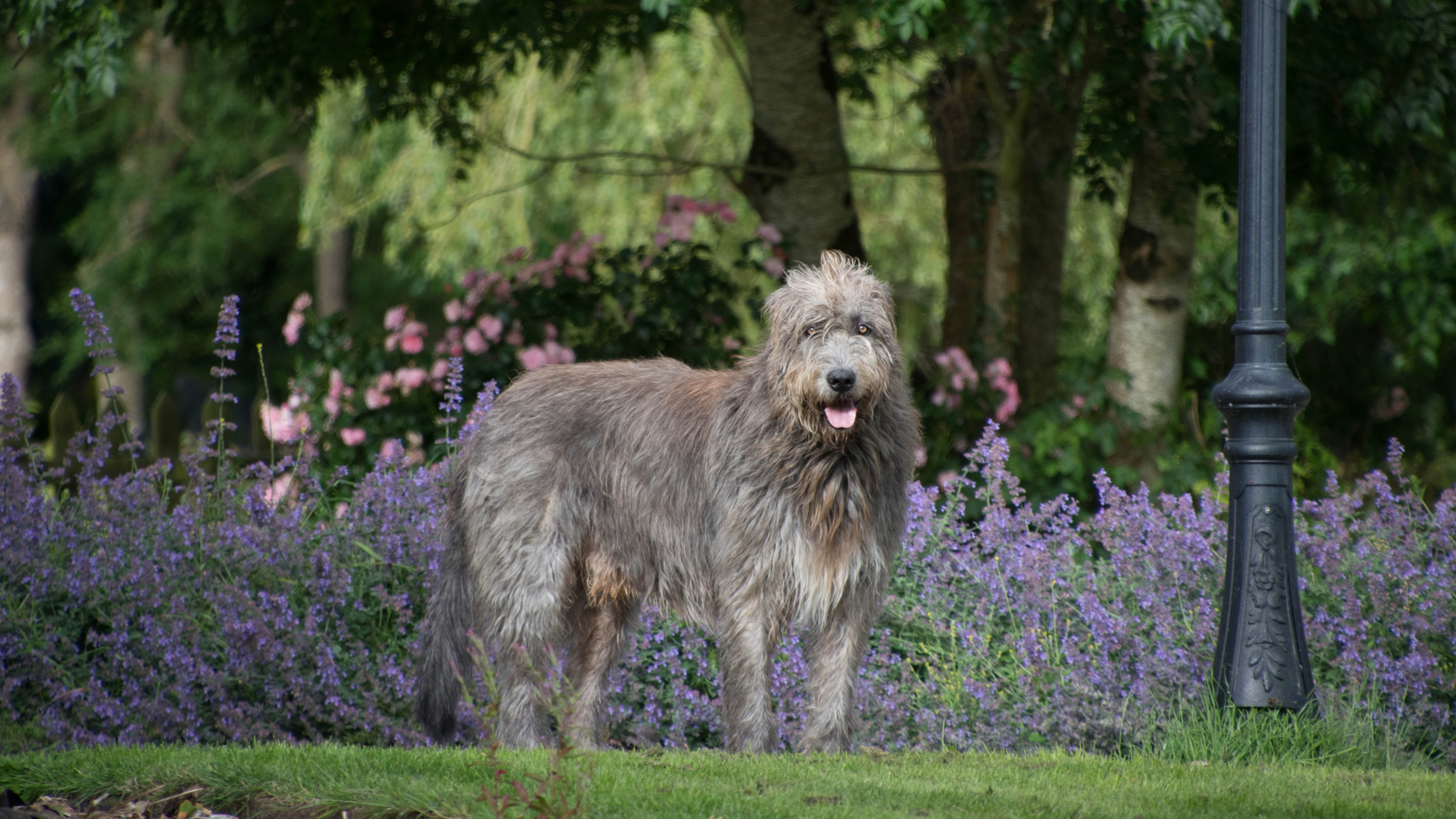
When it comes to health, there are several conditions you'll want to be aware of if you plan on welcoming a Great Dane or Irish Wolfhound into your family.
"The most common health problem I’ve seen in Great Danes is gastric dilatation and volvulus (GDV), where the stomach bloats and twists," Dr Godfrey explains.
"It’s life-threatening and always touch-and-go when a case comes in and we rush to surgery. Irish Wolfhounds can get the same condition, because they also have a deep chest. To reduce the risk of your dog getting a GDV, never exercise them or let them run around after eating; instead, let them rest for an hour to allow the stomach to empty."
Dr Godfrey says that both breeds are also prone to the heart condition dilated cardiomyopathy (DCM).
"Since dogs with DCM often don’t show any symptoms until they are very severely affected, it’s a good idea to get your dog checked regularly," she advises. "A vet can perform a screening blood test and heart scan, as well as their standard examination, to see if your dog needs treatment."
Finally, like many large-breed dogs, both the Great Dane and the Irish Wolfhound are prone to joint problems. Dr Godfrey says that elbow and hip dysplasia, where the joints don't develop as they should, are particularly common.
"Screening tests are available, so if you’re considering taking on one of these breeds, it’s a good idea to speak to the breeder about testing.
Owner suitability: Great Dane vs Irish Wolfhound
Now that you know a little bit more about the Great Dane and the Irish Wolfhound, you may be wondering which breed would be best suited for your home and lifestyle.
Dr Godfrey says that in her experience, neither breed is particularly good with young children, however they are both very affectionate, which makes them well suited to families with older children.
"Because of their large size and strength, combined with not being particularly easy to train, they’re not the best option for first-time dog owners, but they would suit experienced dog owners who have plenty of indoor and outdoor space," she explains.
The Complete Guide to The Great Dane | Amazon
This handbook offers practical advice for Great Dane owners, including training, nutrition, exercise and socialization.
Irish Wolfhound Dog Complete Owners Manual | Amazon
From health advice to training tips, this owners manual has everything you need to know about the Irish Wolfhound, written by a dog expert.
Read next: Great Dane facts and Irish Wolfhound facts

Hannah graduated from the Royal Veterinary College in 2011 and began work straight away at a busy mixed practice. Initially, she treated all species, but focused on small animals from 2014. She has a passion for soft tissue surgery, ultrasound, and canine and feline dentistry, having completed additional training in these areas.
Edited by Megan Milstead.
This page was last updated in May 2025 by Kathryn Williams.

Kathryn is a freelance writer who has been a member of the PetsRadar family since it launched in 2020. Highly experienced in her field, she's driven by a desire to provide pet parents with accurate, timely, and informative content that enables them to provide their fur friends with everything they need to thrive.
Kathryn works closely with vets and trainers to ensure all articles offer the most up-to-date information across a range of pet-related fields, from insights into health and behavior issues to tips on products and training.
When she’s not busy crafting the perfect sentence for her features, buying guides and news pieces, she can be found hanging out with her family (which includes one super sassy cat and a kitten), drinking copious amounts of Jasmine tea and reading all the books.
She has written for a range of publications, including Fit&Well, Top Ten Reviews, LiveScience, Goodto, and Product Hunt.

